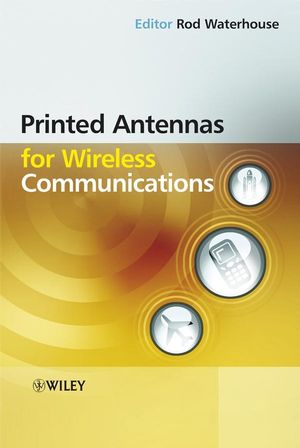Printed Antennas for Wireless CommunicationsISBN: 978-0-470-51069-8
Hardcover
472 pages
December 2007
 This is a Print-on-Demand title. It will be printed specifically to fill your order. Please allow an additional 10-15 days delivery time. The book is not returnable.
|
||||||
List of Contributor.
Preface.
1. Wireless Systems and Printed Antennas (Rodney B. Waterhouse and Dalma Novak).
1.1 Introduction.
1.2 Examples of Wireless Systems.
1.3 New Wireless Platforms.
1.4 Antenna Requirements.
1.5 Fundamental Printed Antennas.
1.6 Outline of the Book.
References.
PART I. FUNDAMENTAL WIDEBAND PRINTED ANTENNAS FOR WIRELESS SYSTEMS.
2. Multilayered Patch Antennas (Wayne S. T. Rowe).
2.1 Introduction.
2.2 Types of Multilayered Patch Antennas.
2.3 Design Trends of Multilayered Patch Antennas.
2.4 Analysis of Layered Structures.
2.5 Summary.
References.
3. Printed Quasi-Yagi Antennas (Kevin M. K. H. Leong and Tatsuo Itoh).
3.1 Introduction.
3.2 Quasi-Yagi Antenna Element.
3.3 CPW-fed and CB-CPW-Fed Quasi-Yagi Antennas.
3.4 Quasi-Yagi Antenna Arrays.
3.5 Active Antennas with Quasi-Yagi Radiators.
3.6 Summary.
Acknowledgements.
References.
4. Printed Spiral Antennas (Chi-Chih Chen and John Volakis).
4.1 Introduction and Historical Overview.
4.2 Spiral Antenna Fundamentals.
4.3 Effect of Ground-Plane Backing.
4.4 Spiral Antenna Miniaturization using Slow Wave Treatments.
4.5 Integration of Dielectric and Inductive Loadings.
4.6 Summary.
References.
5. Printed Folded Beverage Antennas (Rodney B. Waterhouse and Dalma Novak).
5.1 Introduction.
5.2 Proposed Antenna Configuration and General Characteristics.
5.3 Design Trends.
5.4 Low-Profile, Constrained Area Design.
5.5 Three-Dimensional, Constrained Area Design.
5.6 Summary.
Acknowledgements.
References.
6. Printed Tapered Slot Antennas (Amin M. Abbosh, Marek E. Bialkowski and Hing K. Kan).
6.1 Introduction.
6.2 Types of Tapered Slot Antennas.
6.3 Advantages and Disadvantages of Tapered Slot Antennas.
6.4 Theoretical Models for Tapered Slot Antennas.
6.5 Parametric Study of Tapered Slot Antennas.
6.6 Design of Tapered Slot Antennas.
6.7 Feeding Procedures for Tapered Slot Antennas.
6.8 Arrays of Tapered Slot Antennas.
6.9 Applications of Tapered Slot Antennas.
6.10 Summary.
References.
PART II. SMALL PRINTED ANTENNAS FOR WIRELESS SYSTEMS.
7. Planar Inverted-F Antennas (Peter S. Hall, E. Lee, and C. T. P. Song).
7.1 Introduction.
7.2 Single-Frequency Planar Inverted-F Antennas.
7.3 Multiple-Frequency Planar Inverted-F Antennas.
7.4 Reduced-Size Planar Inverted-F Antennas.
7.5 Switched-Band Planar Inverted-F Antennas.
7.6 Applications of Planar Inverted-F Antennas.
7.7 Summary.
References.
8. Small Patch-Based Antennas (Hing K. Kan, Rodney B. Waterhouse, Dean Pavlickovski, and Andrew Y. J. Lee).
8.1 Introduction.
8.2 Microstrip Patch Antennas.
8.3 Variations of the Shorted Patch Antenna.
8.4 Dual-Frequency Shorted Patch Antennas.
8.5 Low Cross-Polarized Antennas.
8.6 Summary.
References.
9. Small Multiband Printed Monopole Antennas(Karu Esselle and Yuehe Ge).
9.1 Introduction.
9.2 Dual-Arm Printed Monopole Antennas.
9.3 A Dual-Arm CPW-Fed Monopole Antenna.
9.4 Three-Arm Printed Monopole Antennas.
9.5 Multiband Printed Spiral Monopole Antennas.
9.6 A Surface-Mount Monopole Antenna.
9.7 Summary.
References.
10. Printed Antennas in Packages(Jennifer T. Bernhard).
10.1 Introduction.
10.2 Effects of the Embedded Environment on Printed Antennas.
10.3 Examples of Other Work on Printed Antennas in Packages.
10.4 Design Methods for Antennas and Antenna Placement in Packages.
10.5 Directions for Future Work in this Area.
10.6 Summary.
References.
PART III. ADVANCED CONCEPTS AND APPLICATIONS IN WIRELESS SYSTEMS.
11 Printed Reflectarray Antennas (Marek E. Bialkowski, Jose A. Encinar, J. A. Zornoza-Ramirez, and F. C.-E. Tsai).
11.1 Introduction.
11.2 Principles of Operation.
11.3 Phasing Methods.
11.4 Single-Beam Reflectarray Design.
11.5 Shaped-Beam Reflectarrays.
11.6 Multibeam Reflectarrays.
11.7 Folded Reflector Antennas.
11.8 Summary.
Acknowledgements.
References.
12. Antennas on Artificial Magnetic Conductors and Other.
Impedance Surfaces (Daniel F. Sievenpiper).
12.1 Introduction.
12.2 High-Impedance Surfaces.
12.3 Surface Wave Bands.
12.4 Reflection Phase.
12.5 Bandwidth.
12.6 Antennas on High-Impedance Surfaces.
12.7 Diffraction Control.
12.8 Tunable Impedance Surfaces.
12.9 Holographic Artificial Impedance Surfaces.
12.10 Summary.
References.
13. Transceiver Architectures for Highly Integrated RF Front-Ends (Sanjay Raman and Richard M. Svitek).
13.1 Introduction.
13.2 Wireless System-on-a-Chip.
13.3 Receiver Architectures.
13.4 Transmitter Architectures.
13.5 Front-End?Antenna Interface and Integration Issues.
13.6 Summary.
References.
14. Frequency-Agile Antennas for a Software-Defined and Cognitive Radio (J. T. Aberle, S.-H. Oh, and G. A. Taylor).
14.1 Introduction.
14.2 Two-Port Representation of an Antenna.
14.3 Automatic Antenna Tuning Unit (AATU).
14.4 AATU Prototype and Test Setup.
14.5 Summary.
References.
15. Antenna Evaluation for Communications with Diversity/MIMO (Rodney Vaughan).
15.1 Introduction.
15.2 Basic Antenna Parameters and Evaluation with Ideal Point-to-Point.
15.3 Noise.
15.4 Gain Factors for Non-Line-of-Sight.
15.5 Summary.
Acknowledgement.
References.
Index.



